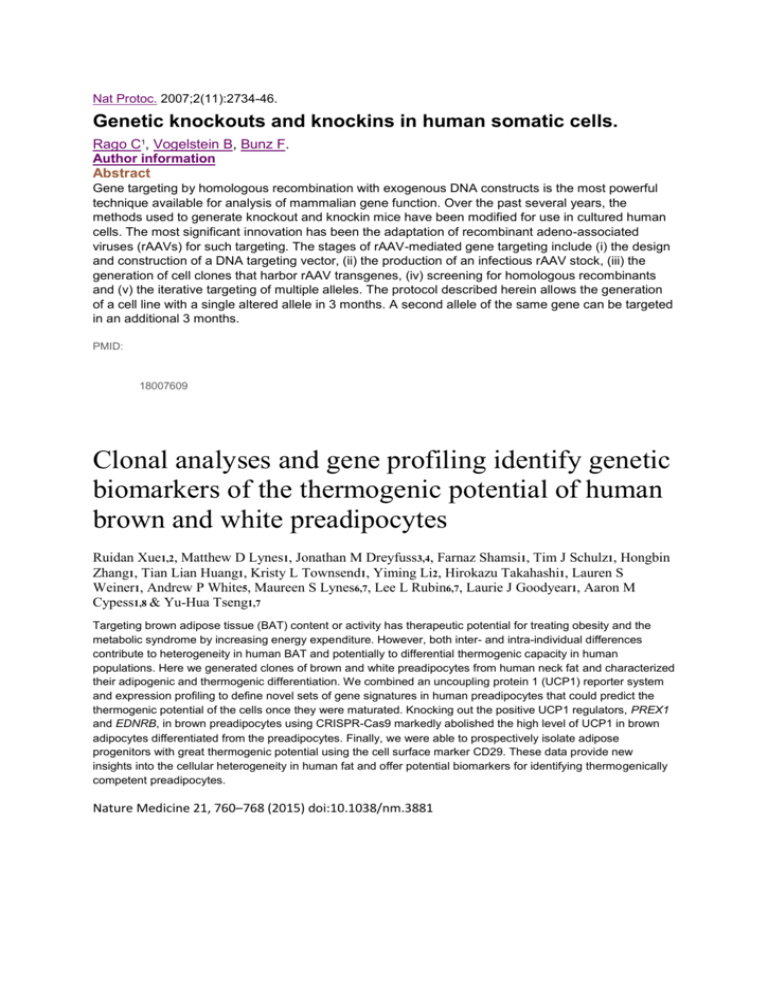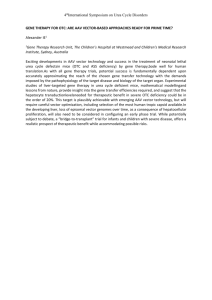Gene editing tech papers not as PDFs
advertisement

Nat Protoc. 2007;2(11):2734-46. Genetic knockouts and knockins in human somatic cells. Rago C1, Vogelstein B, Bunz F. Author information Abstract Gene targeting by homologous recombination with exogenous DNA constructs is the most powerful technique available for analysis of mammalian gene function. Over the past several years, the methods used to generate knockout and knockin mice have been modified for use in cultured human cells. The most significant innovation has been the adaptation of recombinant adeno-associated viruses (rAAVs) for such targeting. The stages of rAAV-mediated gene targeting include (i) the design and construction of a DNA targeting vector, (ii) the production of an infectious rAAV stock, (iii) the generation of cell clones that harbor rAAV transgenes, (iv) screening for homologous recombinants and (v) the iterative targeting of multiple alleles. The protocol described herein allows the generation of a cell line with a single altered allele in 3 months. A second allele of the same gene can be targeted in an additional 3 months. PMID: 18007609 Clonal analyses and gene profiling identify genetic biomarkers of the thermogenic potential of human brown and white preadipocytes Ruidan Xue1,2, Matthew D Lynes1, Jonathan M Dreyfuss3,4, Farnaz Shamsi1, Tim J Schulz1, Hongbin Zhang1, Tian Lian Huang1, Kristy L Townsend1, Yiming Li2, Hirokazu Takahashi1, Lauren S Weiner1, Andrew P White5, Maureen S Lynes6,7, Lee L Rubin6,7, Laurie J Goodyear1, Aaron M Cypess1,8 & Yu-Hua Tseng1,7 Targeting brown adipose tissue (BAT) content or activity has therapeutic potential for treating obesity and the metabolic syndrome by increasing energy expenditure. However, both inter- and intra-individual differences contribute to heterogeneity in human BAT and potentially to differential thermogenic capacity in human populations. Here we generated clones of brown and white preadipocytes from human neck fat and characterized their adipogenic and thermogenic differentiation. We combined an uncoupling protein 1 (UCP1) reporter system and expression profiling to define novel sets of gene signatures in human preadipocytes that could predict the thermogenic potential of the cells once they were maturated. Knocking out the positive UCP1 regulators, PREX1 and EDNRB, in brown preadipocytes using CRISPR-Cas9 markedly abolished the high level of UCP1 in brown adipocytes differentiated from the preadipocytes. Finally, we were able to prospectively isolate adipose progenitors with great thermogenic potential using the cell surface marker CD29. These data provide new insights into the cellular heterogeneity in human fat and offer potential biomarkers for identifying thermogenically competent preadipocytes. Nature Medicine 21, 760–768 (2015) doi:10.1038/nm.3881 Hum Gene Ther. 2005 Apr;16(4):522-6. Gene targeting by adeno-associated virus vectors is cell-cycle dependent. Trobridge G1, Hirata RK, Russell DW. Author information Abstract Adeno-associated virus (AAV) vectors can be used to introduce site-specific mutations into homologous chromosomal sequences. There are many potential applications of this technique, but the process of AAV-mediated gene targeting and factors that influence targeting efficiency are not completely understood. We investigated the dependence of AAV-mediated gene targeting on the host cell-cycle status. The frequency of gene targeting by AAV vectors was compared in dividing and serum-arrested normal human fibroblast cultures. Gene targeting occurred in arrested fibroblast cultures at 0.15 to 1.1% the frequency of dividing cultures, and only took place in cells that had undergone DNA synthesis. Gene targeting was also reduced when DNA synthesis was inhibited by hydroxyurea. PMID: 15871683 Nat Biotechnol. 2006 Aug;24(8):1022-6. Epub 2006 Jul 30. Gene targeting in vivo by adeno-associated virus vectors. Miller DG1, Wang PR, Petek LM, Hirata RK, Sands MS, Russell DW. Author information Abstract Therapeutic gene delivery typically involves the addition of a transgene expression cassette to mutant cells. This approach is complicated by transgene silencing, aberrant transcriptional regulation and insertional mutagenesis. An alternative strategy is to correct mutations through homologous recombination, allowing for normal regulation of gene expression from the endogenous locus. Adenoassociated virus (AAV) vectors containing single-stranded DNA efficiently transduce cells in vivo and have been shown to target homologous chromosomal sequences in cultured cells. To determine whether AAV-mediated gene targeting can occur in vivo, we developed a mouse model that contains a mutant, nuclear-localized lacZ gene inserted at the ubiquitously expressed ROSA26 locus. Foci of beta-galactosidase-positive hepatocytes were observed in these mice after injection with an AAV vector containing a lacZ gene fragment, and precise correction of the 4-bp deletion was demonstrated by gene sequencing. We also used AAV gene-targeting vectors to correct the naturally occurring GusB gene mutation responsible for murine mucopolysaccharidosis type VII. Comment in AAV hits the genomic bull's-eye. [Nat Biotechnol. 2006] PMID: 16878127









